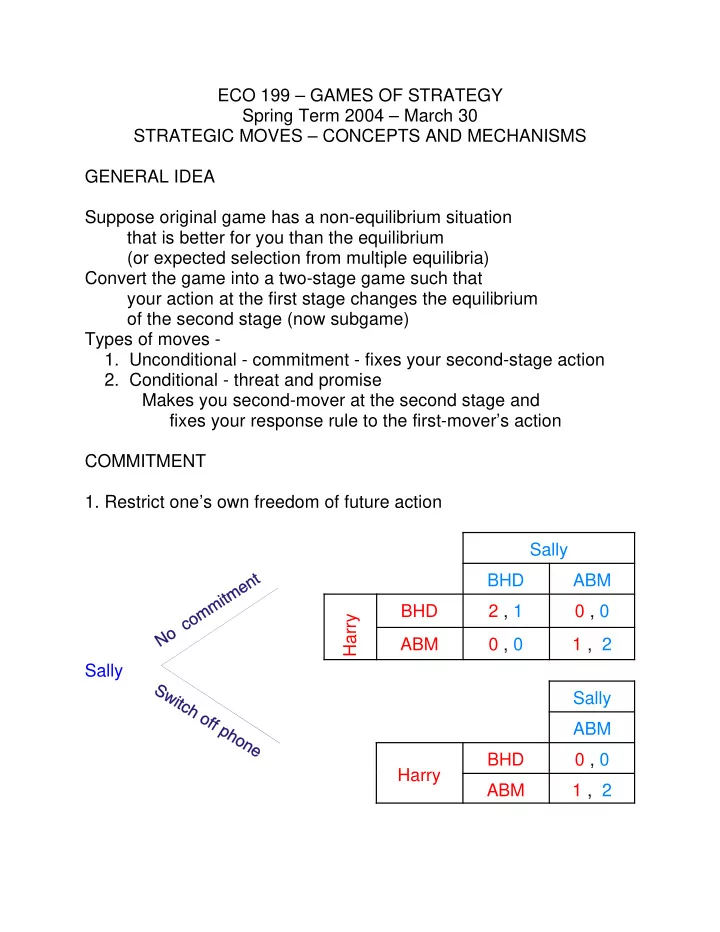

ECO 199 – GAMES OF STRATEGY Spring Term 2004 – March 30 STRATEGIC MOVES – CONCEPTS AND MECHANISMS GENERAL IDEA Suppose original game has a non-equilibrium situation that is better for you than the equilibrium (or expected selection from multiple equilibria) Convert the game into a two-stage game such that your action at the first stage changes the equilibrium of the second stage (now subgame) Types of moves - 1. Unconditional - commitment - fixes your second-stage action 2. Conditional - threat and promise Makes you second-mover at the second stage and fixes your response rule to the first-mover’s action COMMITMENT 1. Restrict one’s own freedom of future action Sally BHD ABM BHD 2 , 1 0 , 0 Harry ABM 0 , 0 1 , 2 Sally Sally ABM BHD 0 , 0 Harry ABM 1 , 2
Commitment effectively changes the game to seize first-mover advantage (if such exists) Your commitment (first move) must be observable and irreversible Don’t have to draw two-stage tree explicitly; can construct the logic of it using second stage alone 2. Change one’s own payoffs Sally BHD ABM BHD 2 , 1 X -1 0 , 0 Harry ABM 0 , 0 1 , 2 COMMITMENT TO DOMINATED STRATEGY U.S.A. Restrained Aggressive Soviet Restrained 3 , 4 1 , 3 Union Aggressive 4 , 1 2 , 2 If no commitment, dominance solvable, outcome ( 2, 2 ) If USSR commits to R, US responds R, outcome ( 3, 4 ) Commitment in USSR’s own interest Difficulty – they may not believe US payoffs are as depicted POSSIBLE FAILURE OF COMMITMENT STRATEGY 1. Communication – other does not see your commitment 2. Credibility – other does not believe your action irreversible or your payoffs correct 3. Simultaneous and conflicting commitment actions
THREATS AND PROMISES You must have the second move in the actual game to follow Create a pre-game where you have the first move, and there commit yourself to a “response rule” (strategy) for your second move in the actual game Issues – Availability of such prior action Credibility of the “conditional commitment” made there THREAT Mugger - “If you don’t give me your money, I will stab you” Not optimal to carry out if actually put to the test Threatened action is costly to threat-maker So credibility problematic; must be acquired by some other device like reputation, irrationality Implicit promise – “If you do give me your money, I will not stab you” automatically credible given these payoffs
PROMISE Prisoner’s dilemma with sequential moves Rollback equilibrium is still Confess, Confess Pianist’s promise “If you don’t confess, I won’t either” Not optimal to carry out if actually put to the test Making good on promise is costly to promisor So credibility problematic; must be acquired by some other device like reputation, escrow account Implicit threat – “If you confess, so will I” is automatically credible General feature of threats and promises – Ex post fulfillment not in your interest So need some other prior action to achieve credibility How to do so is often a matter of art
COMBINATION OF THREAT AND PROMISE One view of game in Congress on President Bush’s first budget Republicans Hardline Flexible Cell (a) Cell (b) Democrats Flexible 2 4 3 3 Cell (c) Cell (d) Hardline 1 2 4 1 (a) Best start for Bush, Democrats get credit for bipartisanship (b) Compromise; everyone in Congress looks statesmanlike (c) Bush’s program blocked; Democrats some blame for gridlock (d) Bad start for Bush; Democrats look fiscally responsible Game is dominance solvable; outcome (a), payoffs ( 2 , 4 ) Can Democrats do better? Commitment – makes no difference, because Republicans have dominant strategy and second move Threat – “If you choose Hardline, so will we” But implied promise not credible Promise – “If you choose Compromise, so will we” But implied threat not credible So need to make both Threat and Promise explicitly And make both credible using repeated interaction or some other device
Recommend
More recommend